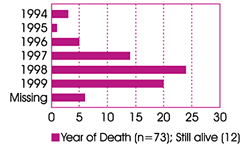Common menu bar links
Institutional links
Diseases & Conditions
Health & Safety
Research & Statistics
Agency Information
Search Box
E-mail this page
Creutzfeldt-Jakob Disease
Quick Links
CJD-Surveillance System
| Newsletters to Families | Newsletters to Physicians |
Newsletter to Physicians May 2000
PDF version ![]() (104 KB)
(104 KB)
[How to download PDF documents]
| May 2000 Highlights
|
CJD Surveillance System
Figure 1. CJD-SS Reports (n=85) and Year of Death  |
The CJD-Surveillance System (CJD-SS) was launched in April 1998 when an information package concerning our project was mailed out to all physicians whom we thought may be involved in the care of persons diagnosed with CJD. As of 1 October 1999, we have had 85 referrals to the CJD-SS from physicians who encounter these cases in their practice (Figure 1). Of these 85 referrals we have had gene sequencing done on 30 and autopsies done on 55. The majority of the reports have been received from Ontario, British Columbia and Quebec; this representation is as expected as this reflects the provinces with the highest concentration of the Canadian population. Of these referrals we have had positive confirmation of CJD by pathology on 39 cases; the remaining were either not definitively confirmed by autopsy (11), definitively diagnosed as other than CJD (four) or still awaiting confirmation (31). We have had three iatrogenic (dura mater-derived) cases as well as three cases of Gerstmann-Sträussler-Scheinker Syndrome (GSSS) reported to the system. No cases of vCJD have been identified in Canada.
| BULLETIN!!! There appears to be some confusion among physicians as to WHEN they should report a case of CJD to the Surveillance System. Many feel that they require definitive diagnosis with positive pathology results before reporting. THAT IS NOT THE CASE. We would like to follow up on ALL probable/possible as well as definite cases of CJD; these should be reported to the system as soon as the diagnosis is made. We would like to be aware of the case before death to ensure that a blood sample can be drawn for genetic sequencing and that arrangements can be made for autopsy. PLEASE inform the Surveillance System of ANY case of possible/probable/definite CJD by calling 1-888-489-2999. |
14-3-3 Protein Immunoassay
This is a highly sensitive and specific method for diagnosis of prion diseases by the detection of protein in the CSF.
The 14-3-3 protein immunoassay in the CSF of patients with suspected CJD has recently been considered as an effective tool for a premortem diagnostic test. The 14-3-3 protein has never been found in the CSF of normal controls and has been reported to be detectable in disorders with a rapid rate of neuronal loss. The 14-3-3 protein is also reported in the CSF of patients with other neurologic diseases including viral encephalitis, herpes simplex encephalitis (HSE), multi-infarct dementia, acute infarction, stroke within 1 month, subarachnoid hemorrhage, and Rett's syndrome. In sporadic CJD, the sensitivity of the 14-3-3 immunoassay is 84%-96%, and the specificity 88%-100%, based on CJD surveillance studies from the USA, UK, France, and Germany. It is not understood why this protein is particularly found in CJD as opposed to the dementing illnesses. However, it is worth noticing that the 14-3-3 protein is not specifically related to prion protein. Furthermore, the sensitivity of the test is much lower in the vCJD than in the sporadic form and negative results can occur presumably in GSSS, a slowly progressing prion disease. According to the method first reported by Harrington(1) we set up an immunoassay of 14-3-3 protein in the CSF in a prion laboratory at the Centre for Research in Neurodegenerative Diseases (CRND), University of Toronto in 1999 to screen out CJD and some familial prion diseases from suspected patients with dementia. So far we have tested 23 CSF samples from the suspected CJD patients and found seven positive cases.
PLEASE contact the CJD-SS by calling 1-888-489- 2999 for more information.
CJD now a reportable disease
CJD has become a disease under national surveillance, effective 1 January 2000. Generally speaking, this means that practicing physicians will report, as they been doing, each case of CJD (probable, possible, and confirmed) to the National Creutzfeldt-Jakob Surveillance Program which is maintained by the Bureau of Infectious Diseases, Laboratory Centre for Disease Control, Health Canada. The Bureau of Infectious Diseases, in turn, will report the case to the provincial health authority in the province of residence of the case. The patient cannot be identified by name; only aggregate data are published once a year in the Notifiable Diseases Annual Summary, a supplement to the Canada Communicable Disease Report. The published aggregate data include province, gender, and age-group.
Reference
- Harrington MG, Merril CR, Asher DM et al. Abnormal proteins in the cerebrospinal fluid of patients with Creutzfeldt-Jakob disease. N Engl J Med 1986 315:279-83.
